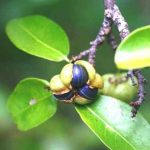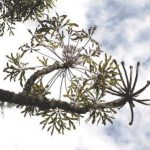TREE LIFE
MAY 1991
MASHONALAND CALENDAR
Tuesday 7th May: Botanic Garden walk with. Tom or Kim; Park your car at the Herbarium where we will meet at 4.45 for 5 pm.
Sunday 19th May AGM
Notice is hereby given that the 41st Annual General Meeting of the Tree Society of Zimbabwe will be held on Sunday 19th May 1991 at 1000 hours at Danbury Park Farm, the home of Tom and Bobs Bayley
AGENDA
Notice Convening the Meeting.
Apologies
Minutes of the 40th A.G.M.
Matters Arising
Chairman’s Report
Treasurer’s Report
Election of Committee Members
Any Other Business
Anyone wishing to serve on the Committee please don’t be shy to come forward at the meeting or write to the Secretary at Box 2128, Harare. It is really very interesting to see what goes on behind the scenes and to play a positive and active role.
Refreshments will be served at 9.30 for which contributions of cakes or sandwiches will be most welcome. After the AGM we will explore an interesting spot nearby, we may even visit the wishing tree! Bring a picnic lunch as usual.
Saturday 25th May: walk with Mark in the Mukuvisi woodlands, meeting at 3 pm the main car park.
Saturday 1st June: Winter time again, so for the next three months our Botanic Garden Walks will be on Saturday mornings at 10.45 for 11am.
MATABELELAND CALENDAR
SUNDAY, 5TH MAY 1991: At last, our visit to the Maleme Tree walk, led by Geoff Archer. Meet at Retreat at 8.30 am. All day, bring your walking legs, lunch and chairs. And enough for a possible $3,00 per car picnic site fee.
WEDNESDAY, 15TH MAY 1991: McHEW (translated means McCausland’s _+_Hillside Evening Walk. Hillside Dam Kiosk at 5.00 p.m. Home before dark. Be there!
SUNDAY 2ND JUNE 1991: Conditions should have dried out at Stone Hills, Marula.
Bookie Peak nearly got stuck in a 4×4: Hence the postponement. Meet at Grafotype, 8l Plumtree Road, at 8.30 am. Cars can be left under lock and key. All day – bring lunch and chairs. Richard Peek will accompany us.
WEDNESDAY 12th JUNE 1991: MCHEW – 5 p.m.
SATURDAY, 20TH APRIL 1991 : DOMBAWERA
Our day was to be a “working” one with Tree Society members identifying and labelling trees for Ian Taylor at his private game ranch “Dombawera” in the Matepatepa area. Here too we are to be accommodated for the night in rondavels within the game area.
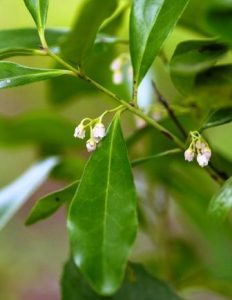
Euclea racemosa. Photo: Bart Wursten. Source: Flora of Zimbabwe
The drive to Dombawera took us first through the citrus to Bindura and then through the beautiful scenery of the Matepatepa hills. We met, ten Harare folk, our hosts and a small group of local tree enthusiasts, over a cup of tea in the open air living area of the lodge overlooking a small dam. Ian, shotgun over his shoulder, led us on our first walk of the day intending to cover about three kilometers, well, he’s not the first person to have had his plans confounded by the Tree Society’s leisurely amble from one species to the next. Each termite mound yielded so much that our progress was slow. Several species growing side by side made for exciting comparisons: Euclea divinorum and E. racemosa with E. natalenesis not far off. Combretum adenogonium, fragrans that was, C. molle, C. hereroense and C. zeyheri in fruit. Diospyros kirkii, D. lycioides and one of the most exciting finds of the day, Maureen’s Diospyros squarrosa confirmed later by Tessa when we got some fruit with its four velvety and rigid calyx lobes curled back. In the vlei Acacia goetzei, A. gerrardii and A. sieberiana. It was satisfying to discover Hexalobus monopetalus and a Ximenia americana both new species to me. Astounding too, to see Cassine matabelica as a tree rather than the small shrub I know.
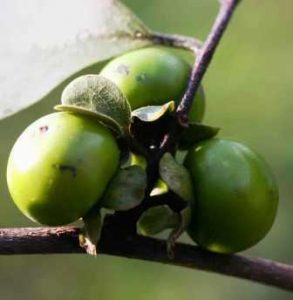
Diospyros squarrosa. Photo: Mark Hyde. Source: Flora of Zimbabwe
I should say that Maureen and Tessa were our “fundis” for the day, so that besides Ian’s “come, come!” ( and eventually “come please”) the bush rang with calls for either or both of them to identify or confirm a find.
Lunch, supplied by our host, was a tremendous spread of salads and cold meats – including bushbuck! After this, while others disappeared to rest or whatever, the “workers” formed a production line and labelled trees in the vicinity of the lodge, one or more persons identified, one read out the tree number, one wrote the label and another hammered it onto a tree. We ran out of labels almost before we ran out of trees: Afzelia quanzensis, Sterculia quinqueloba, Monotes engleri and M. glaber, Ormocarpum kirkii, Ochna schweinfurthiana, Julbernardia globiflora, Pterocarpus rotundifollus, subsp. polyanthus var martinii, just a few of the many species labelled.
Our number was increased by the arrival in the afternoon of Eden Simon and house guests, so we were about twenty five who piled into vehicles for a drive through the park to a kopje in a range of hills nearby. We met Ian’s elephants – five endearing 6 to 7 year olds – on our way there. Our walk round the kopje in mixed woodland yielded exciting additions to our list: Uapaca nitida growing beside U. kirkiana, Protea angolensis and P. welwitschii, Crossopteryx febrifuga and on the rocks Euphorbia ingens, E. matabelensis, some Commiphora africana, C. mossambicensis, and C. mollis.
By this time the sun was low, the light beautiful and golden, and the views quite breathtaking. It was almost a disappointment to see the trucks waiting as we came round the hill. However we had a treat in store, as on our way back to the lodge we stepped off at the “ellies”, now settled for the night in their Stockade, and fed them oranges supplied by Ian. And still the day hadn’t ended for we finished it off with drinks around an enormous fire and a magnificent braai, all produced, once more, by our very generous host. When the day visitors had gone the Harare groups found their beds and collapsed into them, because Ian planned a walk up the kopje behind his house the next morning before breakfast and before going on to the Cottrill’s, there to meet at 9 am, the rest of the Harare members coming up for the Sunday 21st outing at their farm.
Next morning an invigorating walk, more to Ian’s taste, got us up and down the hill in double quick time and added several more species to Maureen’s list.
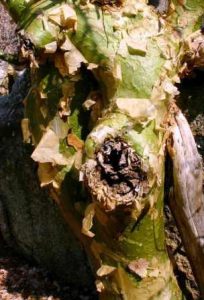
Commiphora marlothii. Photo: Bart Wursten. Source: Flora of Zimbabwe
She had ticked a hundred already – such a suspiciously round number we thought. We found among others Diospyros natalensis, Pappea capensis, Commiphora marlothii, Croton gratissimus which had been taken for white flowers when we had looked up to it at the top of the kopje, Combretum collinum, C. apiculatum and Hymenodictyon floribundum aflame with autumn colour.
It was a day (and morning after) of superlatives – an incredible number and variety of trees, a magnificent setting with far views towards the Chiweshe hills and an exciting lodge where we slept in luxury. However most outstanding was the quite unbelievably generous hospitality of our host. Our thanks to Ian Taylor for an unforgettable visit to Dombawera. We wish him well in his game ranch venture and hope that he receives many visitors to this beautiful and unspoiled part of Zimbabwe.
-Fiona Daw
Sunday 21st April, 1991 – Harare Branch Outing to Matepatapa
This month we were privileged to visit John and Lillian Cottrill on Guitingwood farm which they ran for many years, but which they have now sold, retaining however the right to reside in the house, and to the use of a rather special piece of bush. I think there are about 70 hectares of richly wooded rocks and caves. One of the features of the area was the markedly different range of species from those we are used to near Harare. Another feature was the exceptional size of the trees.
The first tree to arrest the party was a sizeable Crossopteryx febrifuga (Crystal bark). Earlier in the day this had been well tested for the presence of crystals on the underside of the bark, and as we were assured that crystals were present.
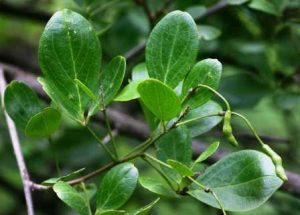
Maerua triphylla. Photo: Bart Wursten. Source: Flora of Zimbabwe
Our next stop was at Pericopsis angolensis, and this was our first “lesson of the day” from Kim. This was to the effect that a once compound leaf with a terminal leaflet cocked at an odd angle, is likely to belong to the pea family (PADILIONACEAE) within the legumes (FABACEAE), as long as the leaves are not arranged in opposite fashion on the stem. This applied to the Pericopsis and also to Lonchocarpus capassa and Pterocarpus rotundifolius which we saw later.
The angled terminal leaflet in this family is a feature resulting from the presence of a pulvinus (seen as a swelling) which connects the rachis to the petiolule of the terminal leaflet. This articulates the leaflet enabling it to track the sun across the sky. Here ended lesson one, and failure to learn it risked one a “brick on the head”! While on Pericopsis we were reminded of another feature of the species, namely distinctive black dead branchlets so different to the white live wood (And, as everyone knows are always on the left hand side of the tree!)
Lesson two was introduced with Pseudolachnostylis maprouneifolia, the duiker berry fruits with three or six chambers is usually associated with monocotyledons (Grasses etc.) but where this is found in a plant clearly a dicotyledon we can expect it to belong to the EUPHORBIACEAE. We saw a further example later in the form of Margaritaria discoidea.
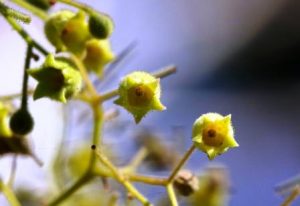
Sterculia quinqueloba. Photo: Bart Wursten. Source: Floraof Zimbabwe
I’m sure that there were many more lessons about recognizing families, but most interesting was the variety of plants, some usually associated with riverine vegetation, like Bequaertiodendron magalismontanum, some more low veld types like Diospyros mespiliformis and Sclerocarya birrea (Marula), and of course the rock dwellers like Commiphora marlothii with its beautiful green bark showing underneath papery peelings, Ficus glumosa pouring its roots over and between rocks; Diospyros natalensis high up out of reach of fire, covered with small orange acorns, and some of the most spectacular Sterculia quinqueloba we have ever seen. They were in their autumn yellows and in flower and young fruit. The fresh pods glisten with golden yellow droplets of sticky pleasantly aromatic resin. According to literature this is a fine quality gum, but as its flow is seasonal it is not commercially exploited. If the name gives you trouble, try remembering “Peculiar stinkallover” which will not only jog the memory, but is very apt. Some of the other Sterculiae really do smell unpleasant, and their generic name comes from ‘Sterculius’, the Roman god of “privies and manuring.”
Of the +- 75 species seen, two were interesting subspecies which we don’t often see. Dichrostachys cinerea which we usually see is the glabrous (smooth) leafed subspecies nyassae. Here. subspecies africana, with smaller very furry leaflets, Rob Pare told us that caterpillars which feed on D. cinerea only occur on the glabrous form, and no amount of starvation will force them to feed on the furry subspecies.
The other interesting subspecies was Pterocarpus rotundifolius (round leafed mukwa bloodwood) subspecies polyanthus var. martinii. I doubt there are any of us who could have identified this correctly as it looked more like P. angolensis without the pointed tips to the leaflets. There are also more than four pairs of leaflets unlike the form we usually see with one to three pairs.
Finally, to return to the marula, Sclerocarya birrea; this seemed to be the only one in the area, though obviously of exceptional size and age. As there was no evidence of fruit or seeds nearby we concluded that it was probably a male tree. Two species of “strangler” fig were attached to it, one with its roots nearly to the ground. However, by the time these strangle the marula it is likely to have expired of old age.
The afternoon walk turned out to be a ‘sit’ as we were treated to a talk on butterflies by Rob Dare. He had brought along beautifully pinned specimens of species which commonly feed off the trees in the area. Julbernardia globiflora was the most important host species with about 9 butterfly species known to feed on it. For me the most interesting part of the subject was how relatively untapped knowledge of our local species is. Even amateurs who come across caterpillars by chance could try to rear them through to adulthood, and could end up with some new information. Male and female butterflies are often quite different, and completely separate species are sometimes almost identical due to mimicry. Butterfly larvae (Caterpillars) use leaves, fruit flesh and seeds as food and are an important food source for spiders, birds, other insects and other animals, including humans. Consider the mopane worm and the caterpillar on Burkea africana which is so desirable that whole trees are felled to harvest it .
Following this the Cottrills gave us a tour of their interests. John is an expert grower of waterlilies and his ponds and tanks were a mass of different-shaped leaves and beautiful flowers in a range of colours. He explained that water lilies can be broadly divided into tropical (leaves with serrated edges, flowers held up above the water on stalks) and hardy temperate forms (leaves with smooth margins, flowers appear to float). He even had lotus, with large nasturtium-shaped leaves, but unfortunately it has never flowered. Some water-lilies are night flowering and are pollinated by night-flying insects.
Along with the water plants John breeds certain species of fish, most noticeable of which were the huge multicoloured kois.
Lillian is a bird artist, and we were amazed by her pictures done in pastels.
A truly memorable and educational trip, for which we thank the Cottrills and Rob Dare.
-Cheryl & Philip Haxen
MATABELELAND NOTES
Mguza Nature Reserve – Sunday, 17th March: The day started badly – a puncture in the garage and with that fixed we set off for the rendezvous at the Falls Road Motors fully expecting a congestion of vehicles worthy of central Johannesburg since both the Tree and the Ornithological Societies were meeting there. We found two cars waiting, one avian and the other arboreal, but worst of all the man from the Municipality was not about and did not appear at all with the key. Geoff Archer (Trees) and than Denny Feather (Birds) arrived but no one else came. Leaden skies and the threat of day-long guti had kept stout Matabelelanders in their warm Sunday beds….
A recce showed the Umguza River gate was locked but that the one on the Nyamandhlovu Road was unchained. So we went in and more or less found the area where Ken thought we should survey, a schist ridge, flattish at first which dipped quite steeply past the new Study Centre down to the edge of the brim-full Lower Umguza dam.
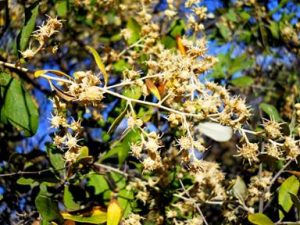
Tarchonanthus camphoratus. Photo: L. E. Lauritsen. Source: Flora of Zimbabwe
There was not much variety. Combretum hereroense and C. apiculatum dominated the high ground but the spectacular and subtly changing browns and creams of C. hereroense fruit was quite marvellous. Each tree seemed to have its own variation of the basic colour scheme. Tarchonanthus camphoratus and Dalbergia melanoxylon were two of the more interesting finds here. The water’s edge gave us Combretum erythrophyllum, not as many as perhaps expected; plenty of Acacia karroo and Diospyros lycioides and some invaders, chief of which was Melia azedarach (Persian lilac or syringa) but Schinus terebinthifolius (Brazilian pepper) was also there.
The great find of the day was a small area less than a hectare, which yielded seven acacia species. There was Acacia arenaria, distinctive with reddish spines and zig-zag branchlets, A. fleckii, A. gerrardii with its downy grey hairs, A. karroo, A. nilotica, its pods hung out for show like so many green necklaces, A. rehmanniana and lastly A. cheriessa (which does not appear on the card for Bulawayo and District!). It was an outing somewhat “quieter“ than usual (Ken wasn’t there). We recorded 38 species and are sending one unknown to the Herbarium.
-IAN MCCAUSLAND
Kloof Farm, Pasipas – 7th April : The weather was perfect, so too were the trees, and a good turnout of members did revision on Acacias. This farm covers an amazing diversity of soil types, and among the Colophospermum mopane scrub we came across Acacia fleckii, A. galpinii, A. gerrardii, A. nilotica, A. rehmanniana, but the great find was Combretum psidioides (the peeling twig combretum) only seen at Gwayi before. The clay soil had not dried out, and although not very hospitable, it still supported Terminalia randii. (a new one for us in this area) and T. sericea, Maerua juncea (a shrub – but another unusual one); Maytenus heterophylla, M. senegalensis, lots of Pavetta schumanniana (a good one for new members, with the black spots in the leaves), Allophylus africanus (always a problem to be solved as we think it has Commiphora schimperi and Rhus pyroides as look alikes), Bolusanthus speciosus, stunted Burkea africana, lots of problem Dichrostachys cinerea and a very large Diospyros mespiliformis surrounded by many small D. lycioides.
Moving to the Kalahari sand area it was fun to see the fruiting Ricinodendron rautanenii (with samples of the cut balsa wood), the velvet seed pods of Baikiaea plurijuga (teak) and a many stemmed and enormous Albizia amara full of pods shining in the sun, a Combretum zeyheri full of yellow pods, not to be confused with the smaller brown pods of C. hereroense, Acacia erioloba with many indehiscent velvety pods, Bauhinia petersiana, some still with their white-rag flowers, both Pterocarpus angolensis and P. lucens showing the pod differences, and sadly a non fruiting Ximenia americana.
We finished off our acacias with A. ataxacantha (flowering), A. goetzei, A. karroo and A. nigrescens (very knobbly). Forging ahead through the Heteropogon contortus (assegai grass!) we reached the shelter of an enormous Ficus thonningii to survey the ridge of hills where our next outing to this fascinating area will be held. Thank you, Anne Visser, for the chance to ramble across this thorny problem area of yours!
-KEN BLAKE
MCHEW — Wednesday, l7th April
As we arrived at Hillside Dams, we were presented with ten photo-copied sheets fitting in with the theme, “feathery leaves”, which consisted of Acacia karroo, (small separated leaflets), A. rehmanniana (oatmeal coloured pods enclosed in a rib), A. robusta subsp robusta (very green and upstanding), A. galpinii (large pods, and thorns) A. nilotica (with beautiful necklets), A. schweinfurthii (the swine with prickles everywhere!) and four other non-Acacias, Pterolobium stellatum (with creamy spike flowers and gorgeous red-wing pods) and Peltophorum africanum (the mis-named wattle), Albizia amara (with bunches of long pods) Dichrostachys cinerea (the Chinese lantern without flowers)-
Bad light stopped the play of another successful evening – thanks Ian.
….AND….
A few of us went on a recent visit to the Mashashasha Falls (also known as the Cascades) in the eastern Matopos. We recorded 105 species on a fantastic 4 km hike of trees, views and scenery. The countryside mainly consisted of groves of Brachystegia glaucescens, but the selection below the canopy made the 45 minute walk into two and a half hours of interest and excitement! Unusually for Matabeleland, we discovered enormous orange hairy caterpillars of the Pochymeta robusta (msasa moth) which, as they only occur on Brachystegia/ Julbernardia trees were quite a find for us. Afterwards we went 12 km further to the Gulubahwe cave, renowned for the fascinating 5-metre-long “snake” painting, with 24 undulations along its back on which are depicted 14 human, and 11 animal figures.
Just beyond, at Dula, a new road (44 km) has been constructed right through “unknown” territory, including 2 out of place, large baobabs (Adansonia digitata) and lots of magnificent Matopos scenery. Definitely a place we must visit again.
-KEN BLAKE
NYARUPINDA CATCHMENT APRIL/MAY 1991
“Run-off”‘ some general knowledge: Did anyone notice a report entitled “Big Demand for Black Granite”? which appeared a few weeks ago in the Mining Supplement to the Fingaz. It dealt with quarrying and dressing dolerite for export. Tree Life No. 121 March 1990 mentioned the occurrence of dolerite, in the form of dykes and sills, which weathers to form fertile red clay soil which supports savanna woodland dominated by Brachystegia species. Ken Blake’s mention of Sarcostemma viminale “witches fingers” in Matabeleland coincided with “Green Snake” being observed here, these two reports are complementary; the writer of this spiel is moved by this coincidence! A few weeks ago neither its name nor its distribution were known. The stems of this strange plant are described as ‘terete’ in botanical literature. “The Rhodesian Botanical Dictionary of African and English Plant Names” deals with a wide variety of indigenous plants and includes Sarcostemma; this reference book is a gem, which should be snapped up at any price.
Last month’s topic of gnarled trees has been followed up at the library of the National Herbarium where evidence from experiments was sought concerning eccentric as opposed to concentric growth of tissues in trees. This information is found under the heading Reaction wood, this is described at undergraduate level by co-authors Zimmerman and Brown …. click, click ….. Albizia zimmermannii grows on John Brown’s Dolomitic Limestone kopje near the Lemon Forest at Dichwe, it was here that Trevor Gordon led us to find many lianes and we picked up the cristate surfaced green fruits of Dregia sp. (ASCLEPIADACEAE). This walk was on May 15th 1977. Do the words Dregia and dregei of Cyathea, the tree fern mentioned by K.B. have any connection? At the Herbarium the following points of interest were noted about lopsided growth in woody perennials.
- A harsh environment where the struggle for survival is severe is not the only reason for unequal growth in trunks and branches.
- Sway and grow fat: more strengthening tissue is produced in the plane of sway. Swaying may increase the activity of cambium at the base of stems and result in prominent “butt swell” of many trees, this has exhilarating human connotations. Cambium under stress forms wider growth rings. The limb may become elliptical in cross section, with its wider dimension in the plane of sway. An active cambium causes reaction wood.
- The force of gravity v. tissue stress, (tension=pulling; compression=weighting down). Cambial activity is influenced by gravity which affects the placement and concentration of growth-promoting hormones called auxins, these may become laterally displaced resulting in a higher concentration on the lower side of branches.
- All the reaction wood is directly related to the amount of auxin on upper and lower sides of stems.
- Every reference consulted confirmed that hardwoods (broadleaved trees) produce tension wood in circumstances where softwood: (cone—bearing trees) form compression wood. This is food for thought.
- In softwood boards and planks, abnormal wood shows as relatively dark reddish streaks along their length.
- Tension wood in English beech (Fagus sylvatica) has gelatinous fibres with a lower content of the wood-forming substance called lignin.
- Compression wood is very dense and lignified, it occurs on the lower side of branches and on the lower side of leaning trees.
- Pulling stress is on the upper side of branches and leaning trees.
Some very dramatic illustrations of trees come to mind whilst writing this; evil faces, wrinkled limbs, contorted attitudes, they were engravings/etchings, embellishing fairy tales, legends. If only the Oxford Companion to English Literature was to hand …. the artist was George Cruikshank, Sir John Tennial, Arthur Rackam? you will know, memory fails me.
Have you noticed that wounded trees heal according to plan; it begins in the cambial zone at the periphery of the injury. Initially wound callus is concentric then successive seasons render it spindle-shaped, a vertical polarity is established because the lateral callus grows more rapidly than that at top and bottom. Sometimes the callus does not meet from all sides, living cells of inner bark are protected but some heart wood is exposed, this according to, a) chemical composition, b) species, may be resistant to further damage by insects and fungi.
George Hall tells us of the fate of a sapling he was watching, recently a long piece of bark was dragged off the Ochna gambleoides near the house. It was almost ring barked by the tractor mower, convolescence will be monitored. This tree seemed large enough and out of the way, to be safe. Ironically the coloured marker was removed by me, shortly before this accident.
At the Herbarium John Ngoni identified the photo of those plants composed of a shiny, pleated, single, geophyllus leaf. He had seen them and said they were Nervilia.
There will be a competition for the most birds and trees identified on a Riding Safari from the Ayrshire Club through to the Mukwadzi river on Perth farm. This event has been arranged by the Makonde Branch of the Wildlife Society of Zimbabwe, it will take place on 27th and 28th April. In the Danga hills on Perth, a double kopje 2 km by 1km in extent, we found a community of Sansevieria aethiopica, luckily a dry flower spike was diagnostic.
On February 27th we rode to collect Carissa edulis berries, what a crop, never seen anything like it before. Nearly three kilograms of fruit were picked in clusters of four and sometimes five, which filled the plastic bags as full as we dared, in a short time. They are cooked as for Rosella (Hibiscus sabdariffa) jelly, it is delicious with meat or ice cream. It can be used to substitute for redcurrant jelly in the preparation of Cumberland sauce.
On April 8th, the wind freshened heralding winter. Rainfall for the season until the end of March was 580 mm. On Thursday (Mar. 28th) at 4 pm in the stillness whilst storm clouds gathered a few large spots of rain came and pawpaw leaves flew across the vegetable garden. The roar of a small whirlwind was a surprise at this time of year. 20 mm of rain fell overnight, no April showers to date.
Next month’s topic, lactiferous trees, shrubs and lianes in the catchment. Then, if space allows, the description of a design for an ecological tapestry.
-Benedicta Graves
Botanic garden walk
During this Month’s Botanic Garden walk we selected various trees, in each case we isolated the most significant feature that aided identification. Once again we must thank Fran Mutapi for her diligent write-up.
THE DICOTYLEDONS
During this month’s Botanical garden walk, we looked at dicotyledons and their families -we looked at both the generalized (primitive) and specialized (advanced) families.
Of the generalized families, we looked at the following families and their family features :
FAMILY LAURACEAE (Laurel or bay leaf family) e.g. Ocotea kenyensis
This Family is very closely related to the MAGNOLIACEAE, its flower components are arranged in threes or multiples of three. The leaves are arranged in a spiral – a typical primitive feature, and have a very aromatic smell.
FAMILY ANNONACEAE (Custard-apple family) e.g. Xylopia
This is another family closely related to the MAGNOLIACEAE, leaves are simple, alternate and arranged in a horizontal plane for maximum light absorption – the leaves also have a very characteristic smell which is actually a feeding deterrent preventing certain animals from feeding on the plant. The members of this family may grow near members of the EUPHORBIACEAE which may possess some similar characteristics, although these may have a leaf arrangement like that which occurs in ANNONACEAE, they do not smell like ANNONACEAE, and usually they have stipules (protective cover of a new leaf) which members of the ANNONACEAE never have. Also occurring in some of the EUPHOBIACEAE is a milky sap (a feeding deterrent) and the distinctive 3 carpels on the fruit. Despite the similarities between these 2 families, they are not related, ANNONACEAE falls within the basal group from which all the other dicots developed and the EUPHOBIACEAE to the edge of the ROSIDAE.
The EUPHORBIACEAE seen during the walk is Euphorbia ingens whose stems have taken over the function of the leaves i.e. formed cladodes.
THE SPECIALIZED FAMILIES
Two families sitting in the most advanced subclass ASTENDAE were looked at these are:
BIGNONACEAE (the Jacaranda family) The family features of this family are the opposite compound leaves which are imparripinate .
APOCYNACEAE (the Oleander Family) This Family, like the EUPHORBIACEAE, has a milky sap – its leaves are simple and opposite – the example seen in Botanical garden was Rauvolfia caffra.
MORACEAE (Fig or Mulberry Family) The leaves in this Family have a milky sap, and stipules as occurs in EUPHORBIACEAE but unlike EUPHORBIACEAE, the leaves are three-veined from the base and unlike APOCYNACEAE the leaves are alternate. The subgenus of Ficus looked at has three species occurring in this country – they all have glands in axils of the veins on the leaves these are shiny green, sometimes brown, armpits. The species, in this subgenus are Ficus sur, F. sycomorus (rough on the top), and F. vallis-choudae.
BURSERIACEAE (the Commiphora Family) The family features are the peeling bark, often with no leaves and a very thin bark. In dry and arid environments, the leaves are lost early in the dry season and the thin bark takes over the function of the leaves. The advantage of this is that the plant reduces its evaporative surface area – i.e. the areas (which would be leaf surfaces) through which water can be lost.
BORAGINACEAE (The Borage Family) e.g.)Ehretia, Cordyla This family’s features is the silicaceous hairs i.e. hairs with silica crystals so that the leaves feel very sandpaperish. e.g. comfrey – these hairs are also a feeding deterrent.
THE FAMILIES WITH COMPOUND LEAVES
The following families have compound leaves as a specialisation:
A THE FAMILIES IN THE ORDER FABALES
Three families are contained within this order and their features are as follows:
MIMOSACEAE: (the Acacia family) . Leaves are compound twice (bicompound) and alternate e.g. Albizia anthelmintica (whose bark kills all the worms in the digestive tract when taken).
CAESALPINIACEAE (the Cassia (Brachystegia family). Leaves compound once, alternate, without an end leaflet e.g. Senna singueana.
FABACEAE (the Pea Family). Leaves compound once, alternate, with an end leaflet imparipinnate which is usually but not always larger than the other leaflets, there is also a slight pulvinus (swelling) on the leaves – e.g. Erythrina and Lonchocarpus.
The Families RUTACEAE end SAPINDACEAE belong to the order Sapindales which has compound imparipinate leaves, with expanded midribs (winged rhachis). The Family RUTACEAE (Cape Chestnut Family) is characterised by oil glands in their leaves which produce the ‘lemon’ smell when the leaf is squashed. The Family SAPINDACEAE does not have the smell.
-F. MUTADI
KIM DAMSTRA CHAIRMMAN


